 Image search results - "Inari" Image search results - "Inari" |

Runners pass by Kaminarimon Gate in Asakusa
|
|

Runners pass by Kaminarimon Gate in Asakusa 東京マラソン 浅草雷門
|
|
|

Runners in Asakusa where they also held various entertainment.
|
|

Fushimi Inari Taisha Shrine is near this JR Inari Station on the Nara Line, a 5-min. train ride from Kyoto Station. Also near Fushimi-Inari Station on Keihan Line.
|
|

I visited Fushimi Inari Taisha Shrine on Jan. 1, 2010. At the Kyoto City Tourist Info office, I asked which shrine was Kyoto's most popular on New Year's Day. They told me it was this shrine, so I came here.
|
|

Loads of people heading for the shrine, but we progressed quickly enough.
|
|
|
|
|
|
|

How it looks from the top of the steps. Hordes of people coming to the shrine to pray for prosperity in the new year.
|
|
|
|
|
|

This is where you can apply (and pay) to enter the shrine hall for prayers.
|
|

The main shrine hall is the target of all these people.
|
|

Fushimi Inari Taisha, Kyoto. Inch by inch, we crept toward the main shrine on New Year's Day.
|
|
|

The crowd behind me.
|
|

The crowd behind me.
|
|

Finally, we got in and could pull these ropes to ring the bell to get the attention of the god of wealth.
|
|

All you hear are these bells ringing overhead.
|
|

The fox is the god's messenger at the Inari Shrine.
|
|

People lining up to enter inside the shrine hall for more personalized prayers.
|
|
|

Lucky charms for sale. Make no doubt, religion is big business in Japan. They are in the business of selling hopes and dreams with no money-back guarantee of success nor satisfaction. Only a religion can get away with selling something which may not work.
|
|

2010 is the Year of the Tiger.
|
|

Another shrine.
|
|
|
|

Fortune papers
|
|

Tying the omikuji fortune papers.
|
|

More lesser shrines
|
|
|

Map of the shrine complex, with a hiking trail up the mountain lined with the famous torii gates.
|
|

Entrance to the hiking trail of torii gates, what Fushimi Inari Shrine is famous for.
|
|

Entrance to the hiking trail of torii gates.
|
|

Go left.
|
|

Inside the tunnel of toriis at Fushimi Inari Shrine in Kyoto, all donated to the shrine by companies.
|
|

Every once in a while along the path of toriis, there is a shrine which you can pray to.
|
|
|
|
|

Votive tablets in the shape of a fox. Write your wishes on it.
|
|

You can also draw your own fox face.
|
|

Continuing up the torii hiking trail. It takes about 90 min. to walk the entire looping trail. You can turn back anytime if it's too hard for you. But it's not a difficult hike.
|
|
|
|
|
|

Some toriis are old and broke off.
|
|
|
|
|
|
|

Gravestone
|
|
|
|
|
|

View from a lookout point.
|
|
|
|
|

Yotsutsuji station, a major rest point.
|
|

Map showing the torii hiking path.
|
|

There are some steps as well.
|
|
|
|

You can buy your own torii and write on it and place it within the shrine.
|
|
|
|

This is at the summit of the mountain.
|
|

Fox at Fushimi Inari Shrine.
|
|
|
|
|

Now I'm going down the mountain. You can then see the writings on the back of the toriis. The name of the company and date are written. Of course, donating a torii here is no guarantee for business success. Some of these companies have gone bankrupt.
|
|
|

You can buy a tray of offerings.
|
|
|
|
|
|
|
|
|
|
|
|
|
|
|
|
|
|
|

Unusual fox
|
|
|
|

Trying to toss coins through the hole for good luck.
|
|

Way out was crowded.
|
|

Inari Station was not so bad.
|
|

For 10 evenings every December near JR Motomachi Station in Kobe, the beautiful Kobe Luminarie holiday lights are displayed amid massive crowds. This is Motomachi Station with a banner pointing the way.
|
|

This was a Saturday, which happened to be the most crowded evening for the lights. About 559,000 people came to see Kobe Luminarie this Sat. evening. Even before 4:30 pm, the crowd starts near Motomachi Station.
|
|

Kobe Motomachi shopping arcade across from Daimaru Dept. Store.
|
|

Joined the line at about 4:45 pm. The lights were to turn on at 5 pm.
|
|

Passing by Ikuta Shrine's torii.
|
|

Well before 5 pm, people already lined up and waited to see Kobe Luminarie. "Luminarie" means "illuminations" in Italian.
|
|

The line formed along these wide roads that were blocked off from traffic.
|
|

The line was long and crowded, but it moved along quite well.
|
|

Near Daimaru Dept. Store at around 5 pm. We were to turn left before Daimaru. This area used to be Kobe's foreigner settlement in the late 19th century.
|
|

Some lights on trees next to Daimaru. The line proceeded pretty quickly after the lights turned on at 5 pm on Sat.
|
|

Kobe Luminarie finally in sight. Everybody was amazed and thrilled as we got closer and closer...
|
|

Entrance called the Frontone (フロントーネ). It looks like a cathedral. Very impressive.
|
|

Kobe Luminarie's Frontone (フロントーネ) in Dec. 2018.
|
|

Kobe Luminarie's Frontone (フロントーネ) in Dec. 2018.
|
|

Tunnel of lights called the Galleria Coperta (ガレリアコペルタ). It goes on for 50 meters. They are all LED lights, 510,000 of them.
|
|

Galleria Coperta (ガレリアコペルタ).
|
|

Galleria Coperta (ガレリアコペルタ).
|
|

Kobe Luminarie's Galleria Coperta (ガレリアコペルタ). This road is lined with luxury brand shops.
|
|

Kobe Luminarie's Galleria Coperta (ガレリアコペルタ) in Dec. 2018. Reminds me of the Galleria in Milan. Distinctly Italian.
|
|

Side of the Galleria.
|
|
|
|
|

The Galleria has another corridor of lights.
|
|
|
|

Kobe Luminarie is made possible by many corporate sponsors and donations from the public. When you put in a coin, etc., into the front slot, the box lights up and I think the doll inside dances or something.
|
|

After the Galleria, you end up at a large park called Higashi Yuenchi (東遊園地). The park has more lights. Very impressive.
|
|
|

This park has twin walls of lights called "Spalliera" (スパッリエーラ). It's like a decorated backboard.
|
|

Flanked by twin Pisa-like towers, the center had the Cassa Armonica (カッサ・アルモニカ).
|
|

Flanked by twin Pisa-like towers, the center had the Cassa Armonica (カッサ・アルモニカ), a bandstand used as a place where people could toss money.
|
|

Kobe Luminarie's Cassa Armonica (カッサ・アルモニカ).
|
|

Kobe Luminarie's Cassa Armonica (カッサ・アルモニカ).
|
|
|
|

Roof above Cassa Armonica.
|
|

Kobe Luminarie's Cassa Armonica (カッサ・アルモニカ). People lined up for the Cassa Armonica like a shrine.
|
|

Kobe Luminarie's Cassa Armonica (カッサ・アルモニカ). People gave donations.
|
|

Back of the lights.
|
|

There were also souvenir booths in the park.
|
|

Souvenir booth
|
|

Booth promoting Rugby World Cup in 2019. Kobe is one of the venues.
|
|

Promoting Rugby World Cup in 2019. Kobe is one of the venues.
|
|

People lined up to donate money and ring this bell.
|
|

The crowd going home. Most went to Sannomiya Station.
|
|

Map around Seibu Yanagisawa Station on the Seibu Shinjuku Line.
|
|
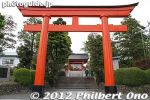
Higashi Fushimi Inari Shrine is a branch shrine of Fushimi Inari Shrine in Kyoto. Near Seibu Yanagisawa Station on the Seibu Shinjuku Line.
|
|
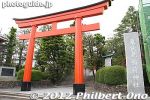
Inari shrines are dedicated to business prosperity. Higashi Fushimi Inari Jinja Shrine is the headquarters of Inari shrines in eastern Japan.
|
|
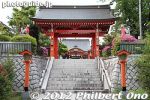
Higashi Fushimi Inari Jinja Shrine was established in 1929 when the god's spirit was split from the kami at Fushimi Inari Shrine in Kyoto.
|
|
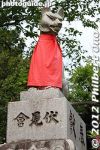
Inari shrine's messenger is a fox.
|
|
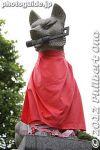
The messenger fox holds a key to the rice granary.
|
|
|
|
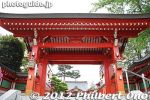
The shrine looks quite new or it has been recently repainted. Colors were bright.
|
|
|
|
|
|
|
|
|

The kamis worshipped.
|
|
|
|
|
|
|
|
|
|
|
|
|
|
|
|
|
|

Map of the smaller inari shrines behind the main hall.
|
|
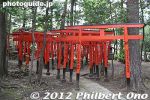
Behind the main worship hall are many smaller inari shrines and numerous torii.
|
|
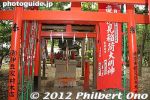
Not as big or impressive as the Inari Shrine in Kyoto, but worth visiting.
|
|
|
|
|
|
|
|
|
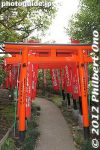
Toriis were donated by companies and individuals.
|
|
|
|
|
|
|
|
|
|
|
|
|
|
|
|
|
|
|
|
|
|
|
|
|
|
|
|
|
|
|
|
|
|
|
|
|
|
|
|

Teppozu Inari Shrine, near Hatchobori Station on the Hibiya subway line.
|
|

In front of the shrine were two large tubs of freezing-cold water with a few large blocks of ice await. The Kanchu Suiyoku (Mid-winter Cold Water Bath) is held on the second Sunday of Jan.
|
|

The men (and one woman) about to take a dip standby in this shrine meeting hall.
|
|

First the shrine priest came out.
|
|

The shrine priest was followed by some 15 or so people ready for their freezin-cold water ablution bath.
|
|
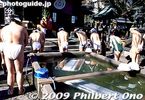
First they give a few prayers led by the shrine priest.
|
|

Then the shrine priest, who was in his 80s, started some warm-up exercises.
|
|

Everyone followed the priest's lead.
|
|
|
|
|
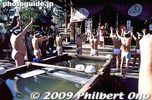
In 2007, the water tub was replaced with a much larger pool able to fit 60 people. But I like this smaller tub.
|
|

There were no musicians on stage like they have now. It was a pretty quiet ritual, and the crowd was quite small.
|
|

Then they ran around the shrine.
|
|

The shrine priest was then the first to enter the bath.
|
|

Without flinching, he took a dip. This is quite tame compared to what he does every Feb: Swim in the icy Sea of Okhotsk off Abashiri, Hokkaido.
|
|
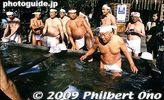
The shrine priest is Nakagawa Masamitsu, still looking youthful in his 80s. This freezing water bath event started at a health club in Ichikawa, Chiba in 1956. But 4 years later, it could not be held any longer so it moved here.
|
|
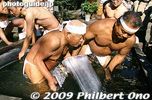
The rest of the people also jump in the tub.
|
|
|
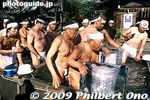
The shrine priest had charisma and spunk.
|
|
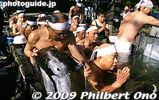
For about 5-10 min. they all sat in the frigid water and chanted while praying. They prayed for good health for themselves and their families.
|
|

Cold-water ablutions is not unusual in ascetic Buddhism, but to see it at a Shinto shrine is unusual.
|
|
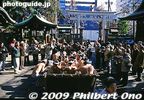
These photos were taken in the 1997.
|
|
|

The man on the lower right kept hugging this big block of ice.
|
|
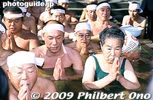
This was the second time I saw this, and each time there was one woman.
|
|
|
|

To this man, ice water is a healthy thing. I know I would never do this.
|
|
|
|
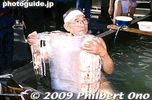
The man is still hugging his ice.
|
|

This shrine priest does not appear in recent photos of this ritual, so he might have passed away. This festival won't be the same without him.
|
|
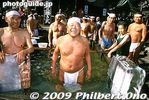
The priest is all smiles after the bath.
|
|
|
|
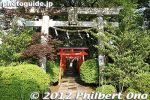
Nearby is Obiki Inari Shrine. 尾曳稲荷神社
|
|
|
|
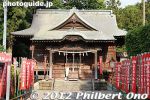
Obiki Inari Shrine. 尾曳稲荷神社
|
|
|
|
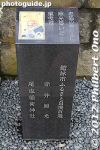
Obiki Inari Shrine is one of Tatebayashi's 100 Famous Spots.
|
|
|
|
|
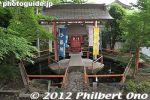
Behind the shrine is this Benzaiten Shrine in a little pond.
|
|

About Benzaiten Shrine
|
|
|
|